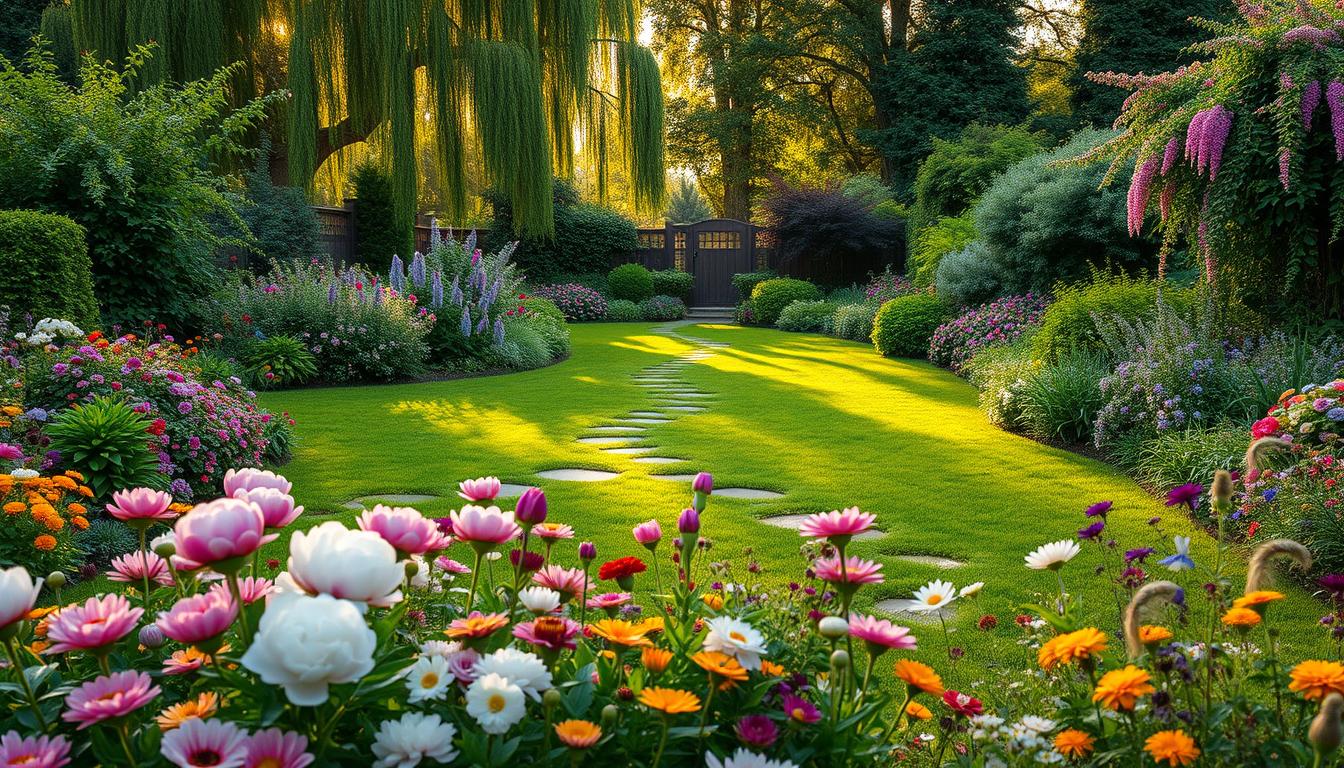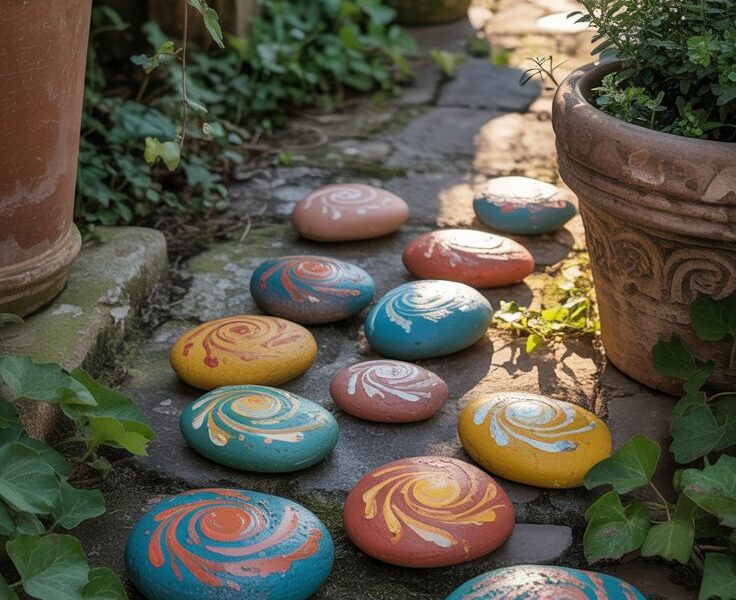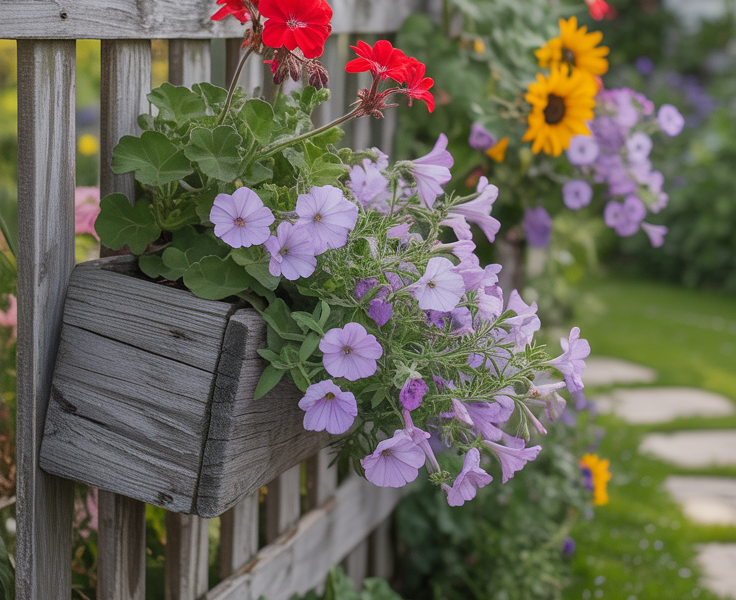Imagine stepping outside to a space that feels like a private nature reserve. Sarah, a homeowner in Ohio, did just that. Last spring, she replaced her plain grass yard with clusters of lavender, sunflowers, and winding stone paths. Now, hummingbirds dart between blooms while her family gathers around a small bubbling fountain.
This kind of makeover isn’t just for experts. Landscape designer Scott Zimmer often uses metal edging to define flower beds and incorporates native plants like coneflowers for low-maintenance beauty. His projects show how simple upgrades create inviting zones for relaxation or play.
Why settle for basic when your outdoor area can tell a story? Structured greenery, water features, and layered plantings add texture and calm. Even modest spaces gain depth with strategic layouts – think cozy seating nooks beside pollinator-friendly shrubs.
Key Takeaways
- Zones with distinct purposes maximize your space’s potential
- Native plants reduce upkeep while supporting local wildlife
- Water elements create soothing focal points
- Edging materials like metal add clean definition to beds
- Layered textures make small areas feel lush
Overview of Transforming Your Lawn into a Floral Retreat
A vibrant floral retreat is just a few design choices away. Start by mapping your space into zones for seating, pathways, and planting areas. Landscape experts like Jenna Monroe recommend combining natural curves with geometric lines to add visual rhythm. “Balance soft-edged flower clusters with clean borders—it creates harmony between wild beauty and order,” she notes.
Choosing the right flowers and colors sets the mood. Warm tones like golden marigolds or red salvias energize social spaces, while cool blues and purples in hydrangeas foster calm. Pair seasonal blooms with evergreen shrubs for year-round texture. For low-water options, try native species like black-eyed Susans or butterfly weed.
| Design Element | Purpose | Example |
|---|---|---|
| Curved Pathways | Guides exploration | Flagstone stepping stones |
| Linear Edging | Defines spaces | Galvanized metal borders |
| Color Blocking | Creates focal points | Grouped purple coneflowers |
Water features elevate the atmosphere instantly. A small fountain or birdbath attracts wildlife while masking street noise. For functionality, add gravel drainage around seating areas or use raised beds to simplify maintenance. The goal? A space that feels both curated and effortlessly alive.
Establishing Garden Zones for Seamless Outdoor Flow
Transform your space into a series of purposeful areas that work together like chapters in a book. Start by sketching zones for dining, relaxation, and activities. A curved gravel path or low hedge can gently guide movement between these areas without rigid barriers.

Defining Functional Areas
Use materials to signal different uses. For example, brick pavers create a crisp transition between a cooking spot and lounge chairs. Water elements, like a narrow reflecting pool, can act as natural dividers while adding soothing sounds. Cluster plants with similar needs together—herbs near the grill, shade-loving ferns beside seating.
Creating Intentional Zones
Think about sightlines and accessibility. Place play areas where you can easily supervise kids from the patio. Install raised beds along walkways for easy harvesting. Landscape designer Mia Torres suggests, “Repeat colors or textures in adjacent zones to create visual harmony.”
Three quick tips for success:
- Use lighting to highlight key areas after dark
- Leave breathing room between zones with decorative stones
- Match plant heights to each space’s purpose (low ground cover near seating)
Backyard Garden Design: From Flat Lawn to Floral Retreat
Your outdoor area can become a living tapestry of color and texture with thoughtful planning. Designers like Lauren Sullivan blend flowing wildflower meadows with crisp stone walkways to transform ordinary yards. “The magic happens when organic shapes meet intentional structure,” she explains. This approach turns unused corners into vibrant pockets of life while maintaining clean sightlines.
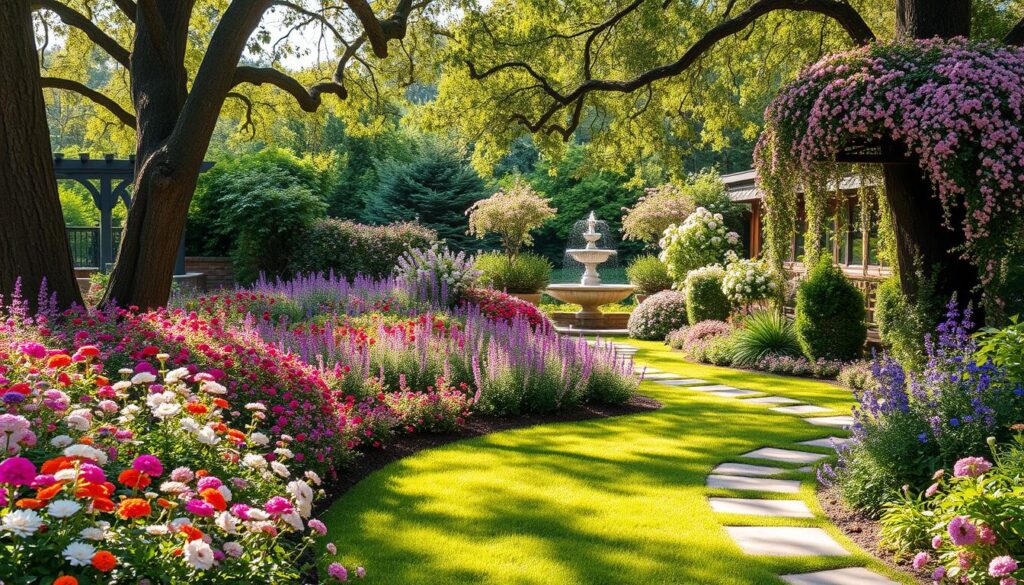
Maximize your space by layering plants vertically. Tall ornamental grasses frame seating nooks, while creeping thyme spills over retaining walls. Pair these with geometric pavers or sleek metal benches for contrast. In one project, Sullivan added a curved pergola draped with wisteria—creating shade while doubling as a flowering focal point.
Three elements make your home feel like a sanctuary:
- Mixed materials (wood + corten steel planters)
- Repetition of key colors across zones
- Hidden storage under benches for tools
For a cohesive look, match your plant palette to your architecture. A modern home might feature spiky succulents and angular water features, while cottage styles lean toward billowy peonies. Even small tweaks—like bordering a patio with lavender—blend practicality with charm. The result? A personalized escape that grows more inviting each season.
Integrating Water Features for a Serene Escape
What if your outdoor space could whisper tranquility? Water elements turn ordinary areas into peaceful retreats. Joseph Kramm, a landscape architect, notes: “Even a modest fountain adds movement and sound that calms the mind.” These features mask traffic noise while inviting birds and butterflies to visit.
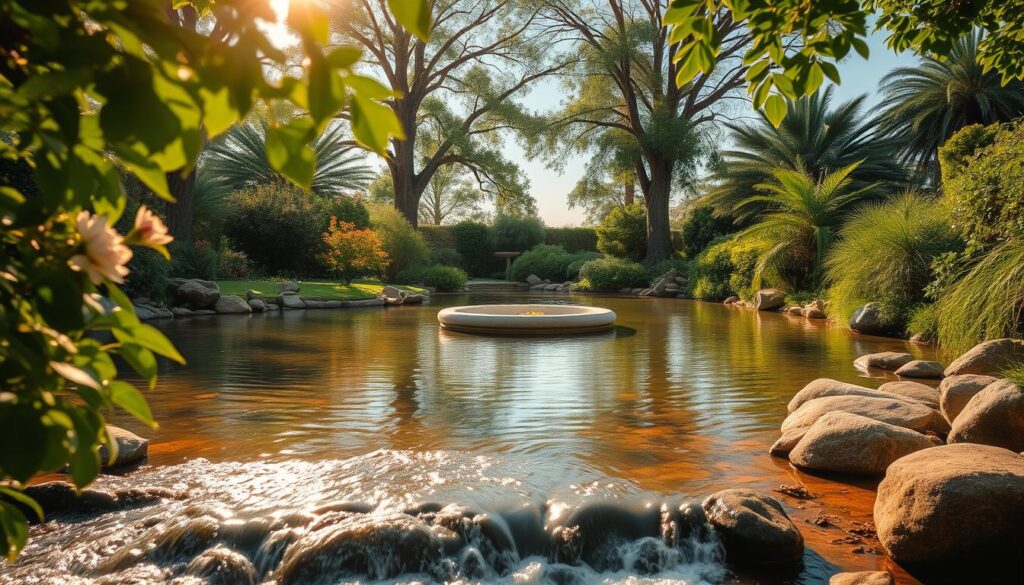
Simple Water Fountain Ideas
Start small with a self-contained bubbler or wall-mounted spout. A feature like a ceramic urn with a recirculating pump works well near patio seating. For DIY options, stack river rocks around a hidden reservoir. Add LED lights for evening ambiance—they’ll dance on the water’s surface.
Poolside Retreat Inspirations
Designer Stacy Zarin Goldberg creates natural pools edged with smooth stones and aquatic plants. Place lounge chairs under trees nearby for dappled shade. For tighter spaces, try a narrow reflecting pool flanked by ornamental grasses. It frames views while cooling the air.
| Water Feature | Benefits | Best For |
|---|---|---|
| Wall Fountain | Space-saving, low maintenance | Small patios |
| Basin Fountain | Attracts wildlife | Central gathering areas |
| Natural Pool | Swimmable & chemical-free | Larger yards with mature trees |
Balance aesthetics with practicality. A stone trough near vegetable beds doubles as a water source for pollinators. For sloped areas, build a cascading stream using local rocks. Remember: moving water needs less maintenance than stagnant ponds.
Using Linear Elements and Structured Greenery for Modern Appeal
Clean lines meet wild beauty in today’s most inviting outdoor spaces. Roger Davies, a leading landscape architect, explains: “Modern design thrives on contrast—think sharp edges softened by billowing perennials.” This approach creates visual tension that feels both intentional and effortless, perfect for summer gatherings or quiet moments surrounded by nature.
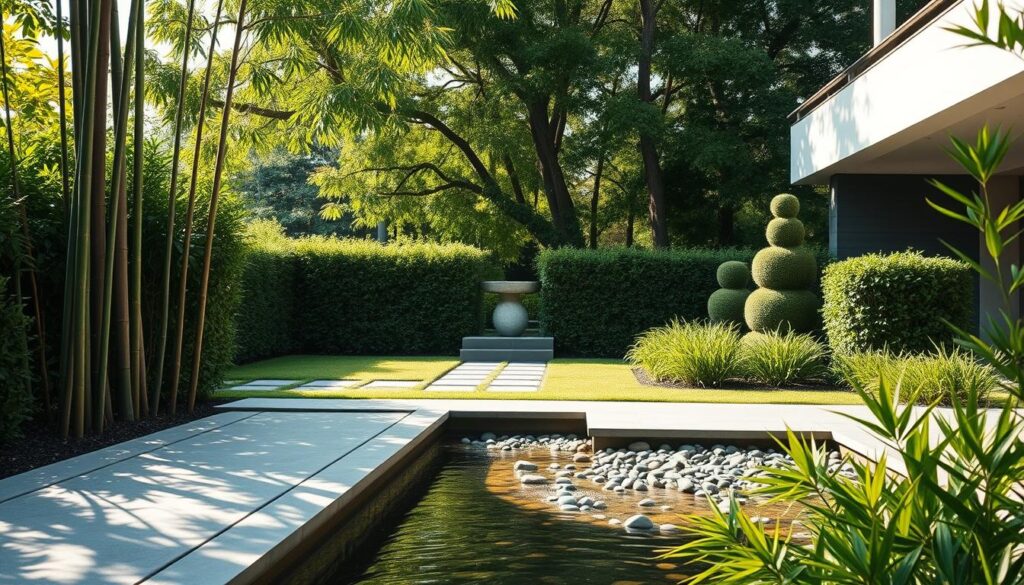
Incorporating Metal Edging Techniques
Scott Zimmer’s projects showcase how metal edging elevates everyday gardening. Powder-coated steel strips define flower beds while preventing grass encroachment. Pair these with drought-tolerant salvia or yarrow for crisp borders that stay neat all summer. Benefits include:
- Reduced weeding time (up to 50% less maintenance)
- Enhanced water drainage along paved areas
- Distinct zones for flowers and pathways
Showcasing Sculptural Greenery
Boxwood spheres and spiral junipers add architectural flair. Frame a front walkway with alternating globes, or flank a water feature with tapered evergreens. Davies suggests, “Use repetition—three identical topiaries create rhythm without feeling rigid.” For texture, mix structured shapes with airy elements like feather reed grass.
| Element | Function | Summer Impact |
|---|---|---|
| Corten Steel Planter | Holds bold hydrangeas | Rusty hue complements blooms |
| Linear Gravel Strip | Separates lawn from wildflowers | Reflects sunlight dramatically |
| Privet Hedge Wall | Creates private nook | Dark green backdrop for bright flowers |
Blend these elements with loose plantings for balance. A geometric patio surrounded by lavender fields or a sleek bench nestled in ornamental grasses proves modern gardening embraces both control and spontaneity. Why not try pairing angular concrete pavers with cascading nasturtiums this season?
Enhancing Your Space with Natural Plantings and Flower Borders
Picture a border where colors shift with the seasons like living brushstrokes. Landscape artist Marion Brenner proves this magic isn’t reserved for grand estates—her lavender fields in California blend wild charm with meticulous planning. Whether framing a cottage path with hydrangeas or edging a patio with feathery grasses, blooming borders transform ordinary spaces into curated art.
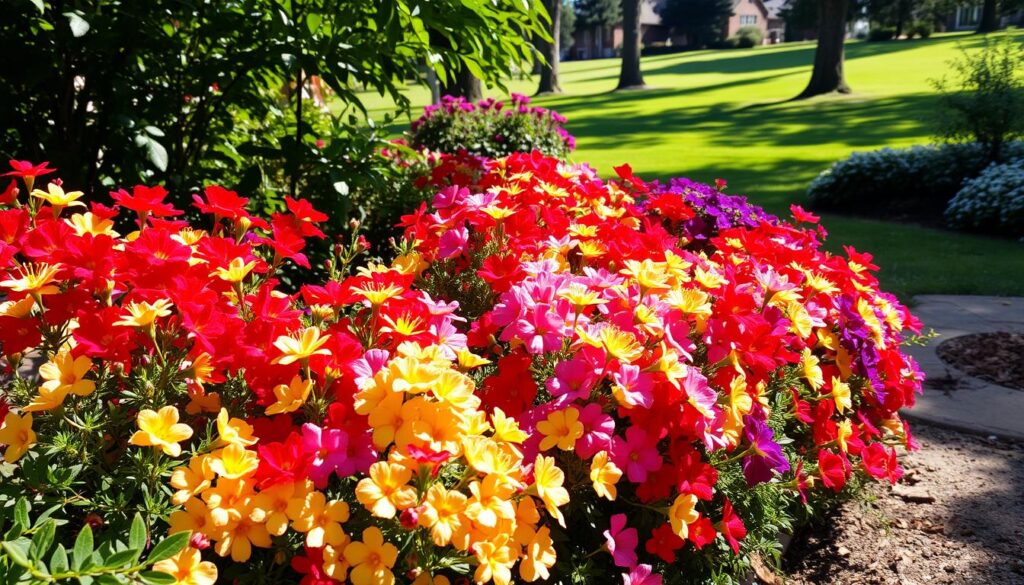
Ideas for Blooming Flower Borders
Start by choosing plants that thrive in your climate and your schedule. For low-maintenance beauty, mix perennials like coneflowers with annuals such as zinnias. This combo ensures vibrant hues from spring through fall. Designer Lauren Sullivan suggests, “Layer heights—tall ornamental grasses at the back, creeping thyme up front—to create depth even in narrow areas.”
Timing matters. Plant bulbs in fall for early spring pops of color, then add summer-blooming salvia as temperatures rise. Set aside one weekend each month for deadheading and fertilizing—this small time investment keeps displays lush.
- Color rhythm: Repeat key shades (like purple sage) across multiple zones
- Texture play: Pair spiky yucca with soft lamb’s ear
- Wildlife boost: Include nectar-rich blooms like bee balm
Create a focal point by dedicating one area to bold groupings. Try clustering ruby-red poppies against a stone wall or planting a crescent of golden coreopsis. These intentional moments draw the eye while feeling effortlessly natural. Remember: borders evolve. Let self-seeding flowers like cosmos fill gaps, embracing surprises as your living canvas grows.
Incorporating Tropical Inspirations in Your Design
Who says you need a plane ticket to experience island vibes? Landscape experts Davis Dalbok and Greg Boyer show how spaces can channel resort energy using bold foliage and clever shade solutions. Their secret? Combining hardy plants with dramatic textures that thrive in diverse climates.

Selecting Tropical-Looking Plants
Create instant vacation energy with species that look exotic but handle cooler zones. Windmill palms survive freezing temps, while agave’s spiky forms mimic tropical edges. Pair these with elephant ears’ giant leaves and ostrich ferns’ feathery fronds for layered drama. Boyer notes: “Texture matters more than origin—plants with oversized foliage create instant escapism.”
Blending Lush Foliage with Shaded Retreats
Build natural canopy layers using pergolas draped with passionflower vines. Underplant with shade-loving caladiums sporting neon-pink veins. For permanent structure, install bamboo screens or cluster potted citrus trees. Three ways to enhance the vibe:
- Use mulch in cocoa bean shells for tropical fragrance
- Add rattan furniture with water-resistant cushions
- Install low-voltage lighting under banana plants
| Plant | Climate Adaptability | Visual Impact |
|---|---|---|
| Japanese Fiber Banana | Zones 5-10 | Massive leaves (6ft long) |
| Hardy Hibiscus | Zones 4-9 | Dinner-plate blooms |
| Cast Iron Plant | Zones 7-11 | Glossy evergreen leaves |
Keep maintenance simple. Dalbok recommends drip irrigation for potted specimens and using slow-release fertilizer in early summer. With these edges between wild and curated, your spaces become daily staycation destinations.
Smart Use of Containers and Hardscaping Elements
Your outdoor space becomes a living gallery when pots and stonework collaborate. Containers let you shift colors and textures seasonally, while permanent structures like gravel paths or stacked stone walls anchor your garden design ideas. Landscape architect Rita Feldman notes: “Planters act as movable sculptures—they fill gaps and create focal points without committing to one layout.”
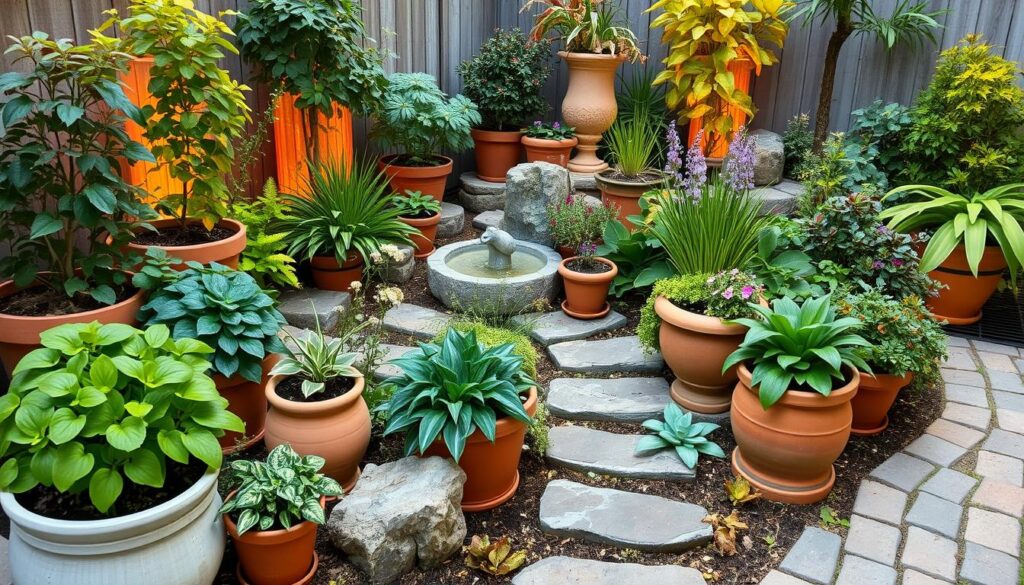
Creative Container Gardening Tips
Pair flower pots with vertical hardscaping for instant depth. Flank a stone partition with tall, wide urns overflowing with trailing ivy. Use rectangular planters to frame gravel ground areas, blending soft blooms with rugged textures. For sunny spots, cluster drought-tolerant agaves in corten steel troughs.
Maximize sunlight efficiency:
- Place sun-loving lavender in full sun zones near seating
- Position ferns in partial sun under pergolas
- Rotate pots weekly to ensure even growth
| Container Type | Best Use | Sunlight Needs |
|---|---|---|
| Ceramic Planters | Entryway statements | Partial to full sun |
| Corten Steel Troughs | Ground-level interest | Full sun |
| Hanging Baskets | Vertical layers | Partial sun |
In small spaces, use tiered stands to showcase herbs or succulents. Balance fixed elements like brick benches with lightweight fiberglass planters you can rearrange monthly. This mix of permanence and flexibility keeps your space fresh yet structured.
Designing with a Calm Color Palette and Textural Contrast
Color and texture work together like quiet music for your eyes. By balancing soft hues with raw materials, you create an outdoor sanctuary that feels both curated and effortlessly inviting. Landscape designer Emma White often notes, “The most calming spaces let colors whisper and textures speak.”
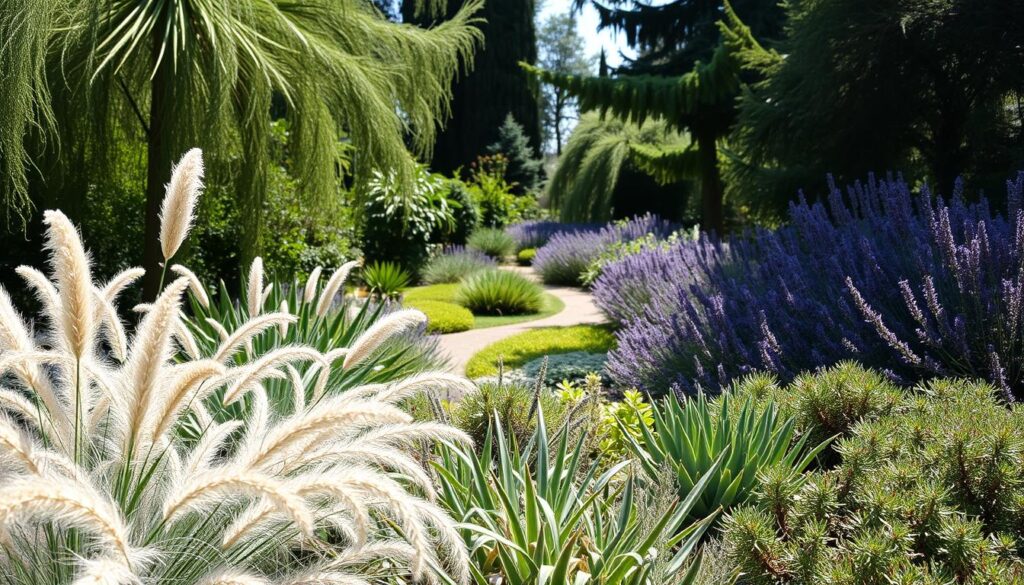
Choosing Complementary Colors
Soft blues paired with warm beiges create instant serenity. Try dusty sage cushions on terracotta seating or pale yellow daylilies against gray stone walls. These combinations work in partial sun or full sun areas, adapting to shifting light throughout the day.
Three ways to harmonize your palette:
- Use a 60-30-10 ratio: dominant neutral, secondary earthy tone, accent color
- Repeat one shade (like muted lavender) across planters and decor
- Add depth with variegated foliage instead of bright flowers
Utilizing Natural Materials for Texture
Rough-cut limestone steps contrast beautifully with velvety lamb’s ear plants. For seating areas, combine smooth teak benches with chunky knit throws. These tactile elements make spaces feel lived-in yet polished.
| Material | Texture Type | Design Impact |
|---|---|---|
| Reclaimed Wood | Weathered grain | Adds rustic warmth |
| Polished Pebbles | Smooth, rounded | Creates Zen-like pathways |
| Moss-covered Stones | Soft and fuzzy | Blurs hardscape edges |
For bold texture inspiration, explore tropical design ideas that balance oversized leaves with sleek surfaces. Remember: contrast doesn’t mean clash. A single rough-hewn planter can anchor a sea of delicate ferns, proving simplicity often makes the strongest statement.
Conclusion
Your journey to a vibrant outdoor sanctuary begins with blending nature’s beauty with smart landscaping ideas. By combining water features with structured greenery and bursts of green foliage, you craft spaces that soothe and inspire. Whether creating dappled shade under a pergola or arranging plants like lavender in geometric planters, every choice builds toward your personal retreat.
Remember how stone pathways guide exploration or how metal edging keeps borders crisp? These practical touches elevate daily moments into serene experiences. Container gardens add flexibility, while complementary colors unify your vision effortlessly.
Now’s the time to start. Sketch zones that reflect your lifestyle—maybe a bubbling fountain corner or a green foliage screen for privacy. Use the landscaping ideas shared here as springboards, adapting them to your climate and tastes.
Your sanctuary awaits. Grab a shovel, pick your first plants like hardy hibiscus or feather grass, and let the transformation begin. What story will your space tell?
